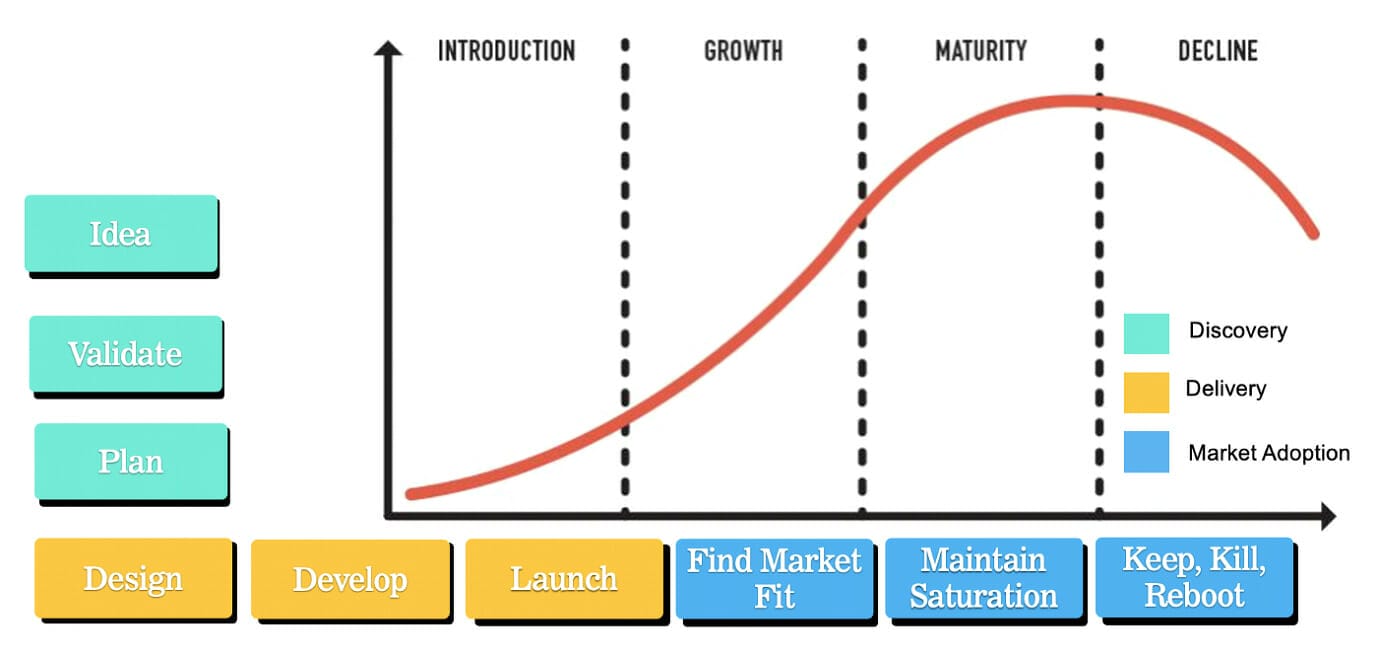What is the Difference Between Product Management and Product Portfolio Management?
Product portfolio management and product management are often treated as the same job, but in reality they are very different. This guide will cover what each function does, and why portfolio management is so important.
This guide will cover what each function does in the organization, plus the key reasons why portfolio management is so critical to product, and how to make the transition.
What is Product Management?
A Product Manager is responsible for the lifecycle of any particular product. They will be tasked with defining the strategy for that product, building requirements, creating and following a roadmap to launch, gathering feedback, and managing and maintaining the product through iterations, feature updates and changes.

Product management involves a wide range of different skills, including the ability to communicate with various stakeholders across the business, a technical understanding to create accurate requirements, and business, research and analytical skills. A Product Manager will take ultimate responsibility for the direction of their product or products, and the buck stops with them when looking at outcomes.
What is Product Portfolio Management?
Product portfolio management is a more strategic role than product management. Often taken on by a lead Product Manager, a Director of Product, or even a VP Product or CPO, one of their tasks will be to take control over the product portfolio, looking at all of the products that a company creates, and understanding their role and their roadmap in a holistic way. They will then plan and execute a product portfolio strategy, which will dictate big decisions for the executive board such as which products to invest heavily in for the next quarter, or which to discontinue or simply maintain.
Product portfolio management involves three distinct steps. First, identification of all the products across the business. Second, evaluating these products in areas such as market potential, customer demand, ROI projections. Finally, prioritizing products based on their potential value to the organization.
Any stakeholder taking on the tasks included in product portfolio management needs to understand the whole portfolio of products and how they align with organizational goals. They should also be able to see at a glance whether products are performing consistently against one another, and identify opportunities and risks. This role requires a strategic mind, a deep understanding of the organization’s objectives, goals and vision, and the ability to work closely with Product Managers to support them in implementing strategic decisions.
Product Management vs Product Portfolio Management
While a Product Manager may be responsible for one product or feature, or even multiple siloed products, product portfolio management looks at how all of the companies’ products work together, impact one another, and how they relate to more high-level organizational goals.
A product portfolio manager is usually not a role in itself. Instead, product portfolio management will be taken on by a Product lead, such as a VP or Head of Product, or even a CPO. It will be likely that they are managing a whole team, including multiple squads of Product Managers, and will need to be able to track and manage the dependencies between different products and product lines. Ideally, they should be able to take multiple data streams and glean insights, views, and roadmaps at the portfolio level – rather than just for a single product.
Why Should You Care about Product Portfolio Management?
There is a lot of business value in ensuring that your product leaders are skilled at product portfolio management.
Without a strategic focus on the product portfolio, you may find that data is scattered across different teams in siloes, there is a gap between strategy at a high level and the tactical work being done by Product teams, and there is a negative impact on transparency and visibility across the business.
If the following challenges seem familiar, you’re likely suffering from the lack of stakeholders managing the overall product portfolio in your organization.
- No big picture: You lean on manual updates and collaboration from multiple siloed Product Managers and their disparate tools. You’ve noticed that you’re spending unnecessary time gathering information from different stakeholders, and you’re concerned about the impact on error rates or alignment of teams.
- Building the wrong products: Each product seems like a success, but product adoption and revenues aren’t where they should be. As you aren’t connecting the granular product work on the ground to higher-level business objectives, the c-suite isn’t seeing the results they want.
- Slow time to market: Another delayed product launch, and your teams are working flat out to get the job done. You need a single view of dependencies across product lines, so that efficiency and accuracy is the name of the game. Wouldn’t it be great if your planning tool could integrate with dev software, too?
- Lack of process uniformity: Every Product Manager uses their own processes, and there is no uniform data model to work with either. That makes gleaning insights across product lines impossible. You have ideas for a unified way of working, but you’re struggling to get adoption.
How Can Product Portfolio Management Help My Organization to Scale?
Any company which is dealing with multiple products or product lines could benefit from product portfolio management, as it provides a single source of truth for all product needs, drilling down to granular information, and then out to organizational objectives. Product portfolio management is equally critical in any industry which works with digital products, whether they are born digital, or have gone through digital transformation.
If you’re a stakeholder who is responsible for leading the organization’s product strategy, and your KPIs are focused on achieving certain high-level business outcomes and showing positive ROI across your product lines, you’re going to see benefits from product portfolio management.
Unlike product management, which cannot see the big picture, as it focuses on a single product or feature alone, product portfolio management helps a company to achieve a wide range of overarching objectives, for example:
- Maximizing revenue: Looking at the product portfolio as a whole, and prioritizing the products and initiatives which have the most potential for profit.
- Developing better products: Understanding customer needs in a more holistic way, and working with Product teams to translate that to the Product roadmap.
- Supporting organizational goals: Aligning the product portfolio with C-suite and executive priorities, giving a single pane of glass to assure cohesion for the business.
If you’re looking to gain more control over the product strategy of the organization overall, and add the ability to make decisions about where to invest and focus so that you can become a lead player in the direction of the business, schedule a demo session with us here.































